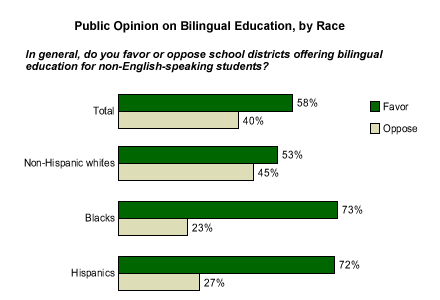At 38.8 million nationwide, Hispanics now make up the largest minority group in the United States, according to U.S. Census statistics released last month. Hispanic immigrants, together with immigrants from all over the world, are pouring into the country in record numbers, and many of them speak little or no English upon arrival. The Census estimates that 18% of U.S. residents usually speak a language other than English at home, and 8% speak English less than "very well."
The announcement that Hispanics now outnumber all other American minorities has consequences for the education community: specifically, what is the best way to educate U.S. students who are not English-proficient?
Bilingual education -- in which non-English-speaking students are taught intensive English language courses together with other subjects (such as math, science, and history) in their native languages -- is a strategy advocated by many education experts and offered in school districts across the country. When asked about bilingual education in Gallup's June 2003 survey on minority rights and relations*, a majority of Americans expressed favorable attitudes toward it: 58% favor "school districts offering bilingual education for non-English-speaking students," and 40% oppose it.
What's the Best Way to Teach English?
But not everyone agrees that bilingual education is the most beneficial strategy for kids who don't speak English. Opponents feel that "English immersion" is the best way to educate students who are not English-proficient, maintaining that students learn English most quickly when they attend classes taught only in English, with English-speaking peers. California, which has one of the highest percentages of immigrant students, switched its schools from bilingual education to English immersion in 1998.
Supporters of bilingual education, including many minority and Hispanic rights advocates, argue that English-only instruction causes non-English-speaking students to lag behind academically, especially in other subject areas that are neglected while students concentrate on learning English.
The issue of how to best educate non-English-speaking students is important for Hispanic Americans, and their views on the subject are quite different from those of white Americans. Gallup's data indicate a significant gap between Hispanics' and whites' opinions on bilingual education -- nearly three-fourths (72%) of Hispanics favor it, compared to just over half (53%) of whites. Interestingly, black Americans -- the vast majority of whom are native English speakers -- hold almost identical views to Hispanics on the issue. Seventy-three percent of blacks surveyed said that school districts should offer bilingual education to non-English-speaking students.

Race is not the only factor influencing Americans' opinions on bilingual education. The gap between Republicans and Democrats on this question is somewhat larger than the gaps among whites, Hispanics, and blacks; 69% of Democrats favor bilingual education compared with 46% of Republicans (a majority of Republicans, 52%, oppose bilingual education). Independents fall in the middle, with 59% in favor.
Support for bilingual education also drops sharply among advancing age categories. Seventy-five percent of 18- to 29-year-olds favor bilingual education, compared to 61% of 30- to 49-year-olds, 49% of 50- to 64-year-olds, and just 44% of people aged 65 and older.
Bottom Line
On June 25, New York City Mayor Michael R. Bloomberg announced that the city would be spending $20 million to strengthen bilingual education programs for New York's 134,000 children who are not English-proficient. Bloomberg has spoken out in favor of English immersion in the past, therefore this surprise turnaround in favor of bilingual education is viewed by many as a move to avoid angering the growing base of Hispanic voters in New York City.
If Gallup's data are any indication, the Hispanic community will favorably view Bloomberg's decision to allocate additional funds to support bilingual education. And if the U.S. Census data are any indication, Hispanic voters will play an increasingly important role in future political decisions.
*Results are based on telephone interviews with 1,385 national adults, aged 18 and older, conducted June 12-18, 2003, including oversamples of blacks and Hispanics that are weighted to reflect their proportions in the general population. For results based on the total sample of national adults, one can say with 95% confidence that the maximum margin of sampling error is ±3%.
Results for the sample of 821 non-Hispanic whites, aged 18 and older, are based on telephone interviews conducted June 12-15, 2003. For results based on the total sample, one can say with 95% confidence that the margin of sampling error is ±4%.
Results for the sample of 241 blacks, aged 18 and older, are based on telephone interviews conducted June 12-18, 2003. For results based on the total sample, one can say with 95% confidence that the margin of sampling error is ±7%.
Results for the sample of 266 Hispanics (including 12 Hispanic respondents who identify their race as black), aged 18 and older, conducted June 12-18, 2003. For results based on the total sample, one can say with 95% confidence that the margin of sampling error is ±7%. (53 out of the 266 interviews with Hispanics were conducted in Spanish.)
In addition to sampling error, question wording and practical difficulties in conducting surveys can introduce error or bias into the findings of public opinion polls.